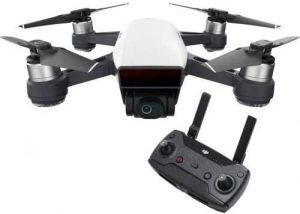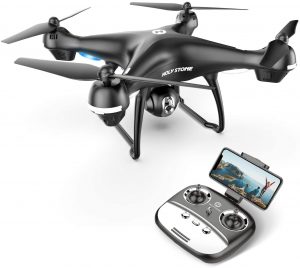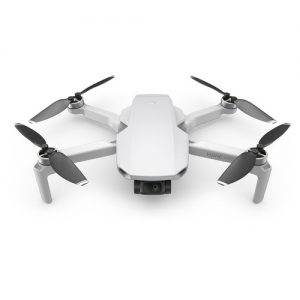Show Contents
Hide Contents
We can never get enough of the popularity and influence drones now have on everyday life. Whether it is merely as a result of popular media influences or it is the steadily advancing hands of technology, one thing is apparent; drones are here to stay. We might as well get comfortable.
As drone technology and innovation continues to allow for varying parameter design, the arrival of state-of-the-art technology comes with the inevitability that drone prices have fallen over the years. For this reason, a series of budget drones have hit the market. Though not the most expensive on the market, these drones are still impressive in their own rights.
In this guide, we are concerned specifically with the best and most recent budget drones that are under $500. It is a somewhat tricky line to straddle the line between staying within a restrictive budget of $500 and trying to find what is optimum. For this reason, we have approached this topic with caution to give you a list of products that fall well within the range of what you need.
The Four Best Drones Under $500 Are Reviewed Below
The drone market has seen a lot of awesome products in the last ten years. This constantly changing landscape has given flight to the popularity of a series of products. The best and most popular products under $500 are discussed in this article.
1
DJI Spark
At a weight of 300 grams, the DJI Spark is a minuscule drone that can fit into the palm of your hand. It comes in a variety of colors including blue, red, and yellow. The camera’s position is beneath the sensor array in front of the drone body.
Fooled by the small size of the DJI Spark, many have ascribed brittleness to the drone’s body. This could not be farther from the truth. The DJI Spark packs a dense, solid plastic body.
The set up of the DJI Spark involves a quick setup of propeller guards and connection to your smartphone for control through the DJI custom application called DJI Go 4. The DJI Spark can also be controlled by hand gestures once an initial stage of face scanning and verification has been carried out. PalmControl, however, has limitations such as a mandatory 10-feet distance for control and being able to only carry out basic navigation commands.
It comes bearing features such as automatic modes called Quickshots (Aerial Selfie mode, Helix plot mode, Rocket mode, and Circle mode) and ActiveTrack mode (for keeping the pilot in the same relative position while flying). The combination of these automatic maneuver modes and its size makes it perfect for use as an indoor drone.
Key Features:
- Autonomous Modes
- PalmControl
- ActiveTrack for positional tracking
- Stabilized Gimbal 12MP Camera
- 31MPH Top Speed
- 16 Minutes Aerial Time
Specification:
- Brand: DJI
- Model: Spark
Pros
- Autonomous modes give automatic control
- PalmControl for easy usage
- Small size enables indoor flying
Cons
- Cannot detect obstacles behind it
- Cannot fly well in heavy wind
- Has a limited range of 50m – 75m
- Has a limited battery life of 16 minutes
2
Holy Stone HS100G Drone
The first striking quality of the Holy Stone HS100 is the bulky design. With dimensions of 50cm by 20cm, this is an enormous drone. It has a net weight of about 700g. Looking at the drone from underneath, the camera is visible. It also comes with highly visible LEDs for transmitter connection notification, GPS notification, and for informing users about battery life remaining.
When it comes to flying, the activity that matters, the Holy Stone HS100 has powerful propellers that kickoff only with one push of a button. The built-in transmitter is one of the most responsive you will find on a drone. It has a transmitting range of about 150m which is on average, quite okay.
Aerial photography is one of the areas in which this drone has less than stellar impressions when compared with drones in this price class. It comes bearing a 720p wide-angle camera on an adjustable camera hold that can be controlled via transmission. Even with this valuable control system, the camera produces images and videos that are not very sharp.
Its battery of 2500mAh gives it about 10-12 minutes of flight time. The powering up of the battery takes a time range of 3-6 hours, depending on the charger adapter. This short time flight can however be managed by getting an extra battery.
The special features on this impressive device include the “Follow me mode” that prompts the drone to follow the transmitter without being controlled. It also has a “Return Home” button that utilizes the GPS function to return the drone to a pre-set start point. Other great features include the Headless mode, altitude hold, emergency stop, and a variable Adjustable speed for flexible control.
Key Features:
- Follow Me Mode
- Adjustable 1080P FHD Camera
- Auto Return Home Mode
Specification:
- Brand: Holy Stone
- Model: HS100G
Pros
- Follow Me Mode aids hands-free freestyling
- Auto Return Home means drone won’t go missing
- Variable Speed mode for various types of users
- Emergency Stop prevents collisions
Cons
- Camera quality is not very sharp
- Video transmitting has a limited range
- Flying time is cut short by limited battery life.
3
DJI Mavic Mini Drone
The DJI Mavic Mini is a masterpiece from DJI. Its popularity has soared since most people learned of how much power it packs while using its tiny size to circumvent the drone laws requiring the registration of drones above a certain weight class (250g in the United States).
This DJI drone combines a 12MP camera with 2.7K video from a 3-axis stabilized Gimbal with portability (250 grams) that ensures it can be flown both indoors and even outdoors.
Its miniature size and weight allow it to stay up in the air for 30 minutes with a fully-charged battery. Even though it requires an Android or IOS device to be fully ready to go, this device is worth it. This drone falls into the category of what many may call an indoor tactical drone because of the wide-ranging features it possesses.
Its design features durable and collapsible arms that can transform for easy packing. Spotting a gray or dark gray shade, it has a pair of dots resembling eyes. Around its back, there is a microSD card slot and micro USB port for charging. Sitting above these features is a flap that holds the battery.
The 250g weight was made attainable by the combination of a sleek design that put the entire drone body at 150g alongside a battery of about 100g. The drawback of this machine is the absent obstacle sensor found on some other DJI Mavic devices.
At a price just under $500, while the DJI Mavic Mini may be lightweight and small in size, it is more than a kid’s toy.
Key Features:
- Half an hour flight time
- Triple axis enabled Gimbal
- 2.5 miles Transmission range
- 30fps 2.7K Camera
Specification:
- Brand: DJI
- Model: Mavic Mini
Pros
- Easy-to-fly features
- Flexible modes for flying
- Design sidesteps need for regulation
- Compact size for indoor flying
Cons
- Has no sensor for automatic detection of obstacles
4
Ruko F11 Pro Drone
The Ruko F11 Pro has a simple, rectangular-shaped body with propeller arms that are foldable along the lateral edges of the drone body. Folding makes it compact for easy transportation from place to place. Its body is designed using a superior quality plastic that safeguards the drone in case of a crash or collision.
The Ruko F11 is a perfect drone for beginners because of its beginner assistive features such as speed setting. It comes with brushless motors as well, ensuring that overheating is prevented. The downside is the exposure to the atmosphere, necessitating the need for careful upkeep.
The powerful motors ensure that the drone can attain top heights of 120 meters with moderate resistance to heavy wind. The transmitting range of this drone has been measured to be around 1220 meters at a 2.4GHz frequency, giving it enough distance in case of racing activities.
One of the most remarkable pieces of hardware is the double 2500mAh batteries that can each supply approximately 30 minutes of flight time. As most drone users will testify, a total one hour of flight time is almost unprecedented as far as drones are concerned.
Other flight functions that put this beast beyond the reach of other less expensive drones include the variable speed modes, GPS enabled positioning, Headless mode, Follow-Me mode, and one key take-off/landing features. At a price that is under $500, this device is worth every dollar you spend on it.
Key Features:
- Flight time of one hour
- Headless mode
- Follow me mode
- One button take-off/landing
Specification:
- Brand: Ruko
- Model: F11 FPV
Pros
- Double batteries give a long flight time
- Long transmitting range for racing
- Brushless motors prevent overheating
Cons
- Brushless motors require extra care
- Has no sensors for automatic obstacle detection
Buying Guide Questions
There are many factors and questions worth considering when it comes to drones. The following questions often asked by people curious about the world of drones and drone technology have been tackled and answered below.
How are military drones controlled?
Military drones are controlled by a complex connection of satellites at the ground station and around the world. What happens is that a ground-control station initially controls the drones when the drone is within the station’s line of sight. However, as soon as the line of sight is lost, a Ground station satellite communicates with space satellites that in turn communicate with the drones. The system ensures that drones are always within the reach of the operators since the space satellites are usually located at an orbital distance big enough to cover the atmosphere around the earth.
How much money does a drone pilot make?
Drone pilot salaries and wages are not a fixed number. The earnings in this increasingly lucrative venture are determined by factors such as industry niche, type of drone being flown, the experience of the pilot, and the particular employer for which one works.
On average, professional drone services (within surveillance, imaging, and photography departments) have been reported to pay a median salary of $60,000 – $70,000. In rare cases, salaries have been reported to soar as high as $200,000.
Flying part-time has been found to earn in the range of $300 – $500 per week.
How much do drone pilots make an hour?
Even though drone pilot salaries and wages are subject to many factors, drone wages have been found to be around $22-$24 on an hourly basis.
Can drones be used to spy?
The question of whether drones can be used to spy can be seen in how much drones are being used in surveillance technology around the world. Media companies now talk about the increased capacity of drones to monitor unsuspecting people all over the world. Drones can indeed be used to spy but government regulations and human rights bodies continue to mitigate the levels to which such surveillance activities are carried out.
What are the disadvantages of drones?
Depending on the context in which drones are supposed to be applied, a plethora of disadvantages has been known to be associated with drones. The technological disadvantages include limitations such as weather limitations and brief flying time. The main disadvantages, however, are social issues such as security implications like spying/surveillance/terrorism and risk of injury in the instance of a collision.
Do police use drones to spy?
Yes, security agencies in a few parts of the world have now become associated with their drones. Police actions usually involve drones in a few Asian countries where civil rights violations on the part of government are being continuously criticized.
Can drones fly in rain?
One of the biggest issues with flying drones is the drawback associated with weather. Drones have electronic and mechanical parts that are sometimes not well equipped to function in rainy or windy environments, however, technology is being continuously innovated that makes drones more able to withstand rainfalls and heavy wind.
Related: If water resistance is important, then RC Fishing Boats or RC Drones for Fishing might serve you better.
Conclusion
The trend of innovation pertaining to drone technology has seen prices of drones drop so much that a lot of decent drones can now be purchased with less than $500. The availability of information about these drones has been challenging for many who seek to really utilize their money. This piece tries to bridge the gap between how much users have and what they want their money to go into.
Insider Tip: if you have a larger budget, then these drones will work even better, conversely, if you have a lower budget, then these picks will help narrow down your options






